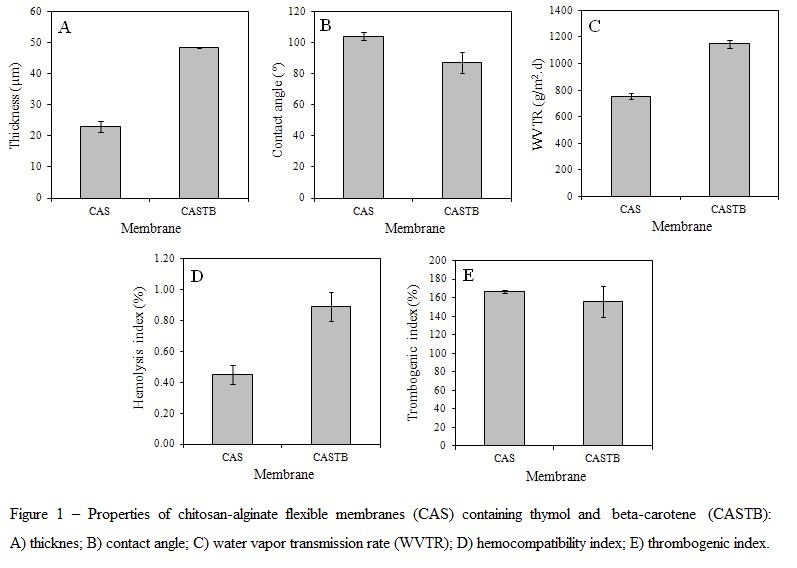Introduction: Biodegradable polysaccharides are widely used in the production of wound dressings, mainly cellulose, chitosan (C) and alginate (A). CA polyelectrolyte complexes are already established for those applications and their flexibility is significantly increased by the addition of the silicone gel Silpuran®2130A/B (S) (Pires and Moraes, 2015). The incorporation of natural bioactive agents such as thymol (T), which has anesthetic properties, and of the anti oxidant compound beta-carotene (B) in CAS membranes may add value to these dressings, improving their performance regarding pain reduction and more effective and faster wound healing. The purpose of this work was to determine the changes in physical and biological properties of CAS membranes resulting from the incorporation of T and B in the biomaterial using supercritical carbon dioxide (scCO2).
Material and Methods: Membrane production was based on the procedures proposed by Bueno et al. (2014) and Pires and Moraes (2015), using chitosan and sodium alginate of low viscosity from Sigma-Aldrich and Silpuran®2130A/B from Wacker Chemie. The incorporation of T (at 10% of its maximum solubility in ethanol) and B (at its maximum solubility in ethanol), both from Sigma-Aldrich, using scCO2 was realized based in Dias et al. (2011).
The membranes were characterized regarding thickness (with a micrometer), contact angle of water (using an OCA20 equipment), water vapor transmission rate (according to ASTM E96-90D, 2010), hemocompatibility (based on ASTM F 756-00, 2000) and thrombogenicity (according to Imai and Nose, 1972).
Results and Discussion: The results attained are summarized in Figure 1. The incorporation of the natural compounds increased the thickness, hydrophilicity and water vapor transmission rate (WVTR) of the membranes, being potentially a result not only of T and B incorporation but also a consequence of the exposure of the biomaterial to the impregnation conditions (250 bar and 50°C), which probably contributed to modify the organization of the polymeric chains. The values obtained point to the application of the membranes in moderate exudative lesions (Dias et al., 2011; Lee et al., 2012).

According to ASTM F756-00 (2000), the membranes remain non-hemolytic after T and B incorporation (values below 2). Thrombogenicity was not reduced enough after T and B incorporation to characterize the membranes as non thrombogenic. However, the capacity to form thrombus may be considered advantageous if the lesion to be treated is bleeding.
Conclusion: The incorporation of T and B in CAS membranes using scCO2 methodology favors the increase of their thickness, hydrophilicity and WVTR. The attained biomaterial is non-hemolytic and may be successfully used in blood clotting, being adequate to treat moderate exudative lesions.
Conselho Nacional de Desenvolvimento Científico e Tecnológico (CNPq, Brazil); Coordenação de Aperfeiçoamento de Pessoal de Nível Superior (CAPES, Brazil); Fundação para a Ciência e a Tecnologia (FCT, Portugal).
References:
[1] American Society for Testing and Materials ASTM E96-90D: Standard Test Methods for Water Vapor Transmission of Materials, 2010.
[2] American Society for Testing and Materials ASTM F756-00: Standard Practice for Assessment of Hemolytic Properties of Materials, 2000
[3] Bueno, C. Z.; Dias, A. M. A.; Sousa, H. J. C.; Braga, M. E. M.; Moraes, A. M. Mater. Sci. Eng. C 2014, 44, 117.
[4] Dias, A. M. A.; Braga, M. E. M.; Seabra, I. J.; Ferreira, P.; Gil, M. H.; Sousa, H. C. Int. J. Pharm. 2011, 408, 9.
[5] Imai, Y.; Nose, Y. J. Bio. Mat. Res. 1972, 6, 165.
[6] Lee, Y.; Chang, J.; Yang, M.; Chien, C.; Lai, W. Carb. Polym. 2012, 88, 809.
[7] Pires, A. L. R.; Moraes, A. M. Appl. Polym. Sci. 2015, 132, 41686.